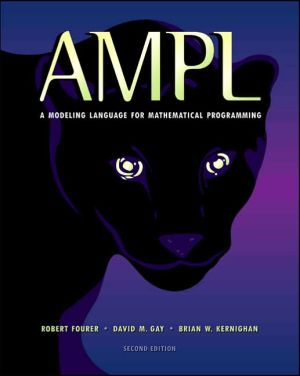

 |

|

Sold Out
Book Categories |
1. PRODUCTION MODELS: MAXIMIZING PROFITS. A two-variable linear program. The two-variable linear program in AMPL. A linear programming model. The linear programming model in AMPL. Adding lower bounds to the model. Adding resource constraints to the model. AMPL interfaces.
2.DIET AND OTHER INPUT MODELS: MINIMIZING COSTS. A linear program for the diet problem. An AMPL model for the diet problem. Using the AMPL diet model. Generalizations to blending, economics, and scheduling.
3.TRANSPORTATION AND ASSIGNMENT MODELS. A linear program for the transportation problem. An AMPL model for the transportation problem. Other interpretations of the transportation model.
4.BUILDING LARGER MODELS. A multicommodity transportation model. A multiperiod production model. A model of production and transportation.
5.SIMPLE SETS AND INDEXING. Unordered sets. Sets of numbers. Set operations. Set membership operations and functions.
Indexing expressions. Ordered sets.
6.COMPOUND SETS AND INDEXING. Sets of ordered pairs. Subsets and slices of ordered pairs. Sets of longer tuples. Operations on sets of tuples.
Indexed collections of sets.
7.PARAMETERS AND EXPRESSIONS. Parameter declarations. Arithmetic expressions. Logical and conditional expressions. Restrictions on parameters. Computed parameters. Randomly generated parameters. Logical parameters. Symbolic parameters.
8.LINEAR PROGRAMS: VARIABLES, OBJECTIVES AND CONSTRAINTS. Variables. Linear expressions. Objectives. Constraints.
9. SPECIFYING DATA. Formatted data: the data command. Data in lists. Data in tables. Other features of data statements. Reading unformatted data: the readcommand.
10.DATABASE ACCESS. General principles of data correspondence. Examples of table-handling statements. Reading data from relational tables. Writing data to relational tables. Reading and writing the same table.
Indexed collections of tables and columns. Standard and built-in table handlers.
11.MODELING COMMANDS. General principles of commands and options. Setting up and solving models and data. Modifying data. Modifying models.
12.DISPLAY COMMANDS. Browsing through results: the display command. Formatting options for display. Numeric options for display. Other output commands: print and printf. Related solution values. Other display features for models and instances. General facilities for manipulating output.
13.COMMAND SCRIPTS. Running scripts: include and commands. Iterating over a set: the for statement. Iterating subject to a condition: the repeat statement. Testing a condition: the if-then-else statement. Terminating a loop: break and continue. Stepping through a script. Manipulating character strings.
14.INTERACTIONS WITH SOLVERS. Presolve. Retrieving results from solvers. Exchanging information with solvers via suffixes. Alternating between models. Named problems.
15.NETWORK LINEAR PROGRAMS. Minimum-cost transshipment models. Other network models. Declaring network models by node and arc. Rules for node and arc declarations. Solving network linear programs.
16.COLUMNWISE FORMULATIONS. An input-output model. A scheduling model. Rules for columnwise formulations.
17.PIECEWISE-LINEAR PROGRAMS. Cost terms. Common two-piece and three-piece terms. Other piecewise-linear functions. Guidelines for piecewise-linear optimization.
18.NONLINEAR PROGRAMS. Sources of nonlinearity. Nonlinear variables. Nonlinear expressions. Pitfalls of nonlinear programming.
19.COMPLEMENTARITY PROBLEMS. Sources of complementarity. Forms of complementarity constraints. Working with complementarity constraints.
20.INTEGER LINEAR PROGRAMS. Integer variables. Zero-one variables and logical conditions. Practical considerations in integer programming.
Appendix A: AMPL REFERENCE MANUAL. INDEX.
Login|Complaints|Blog|Games|Digital Media|Souls|Obituary|Contact Us|FAQ
CAN'T FIND WHAT YOU'RE LOOKING FOR? CLICK HERE!!! X
 You must be logged in to add to WishlistX
 This item is in your Wish ListX
 This item is in your CollectionAMPL: A Modeling Language for Mathematical Programming
X
 This Item is in Your InventoryAMPL: A Modeling Language for Mathematical Programming
X
 You must be logged in to review the productsX
 X
 X

Add AMPL: A Modeling Language for Mathematical Programming, AMPL, developed at AT&T's Bell Laboratories, is a powerful, yet easy-to-use modeling environment for problems in linear, nonlinear, network, and integer programming. Users can formulate optimization models and analyze solutions using common algebraic , AMPL: A Modeling Language for Mathematical Programming to the inventory that you are selling on WonderClubX
 X

Add AMPL: A Modeling Language for Mathematical Programming, AMPL, developed at AT&T's Bell Laboratories, is a powerful, yet easy-to-use modeling environment for problems in linear, nonlinear, network, and integer programming. Users can formulate optimization models and analyze solutions using common algebraic , AMPL: A Modeling Language for Mathematical Programming to your collection on WonderClub |